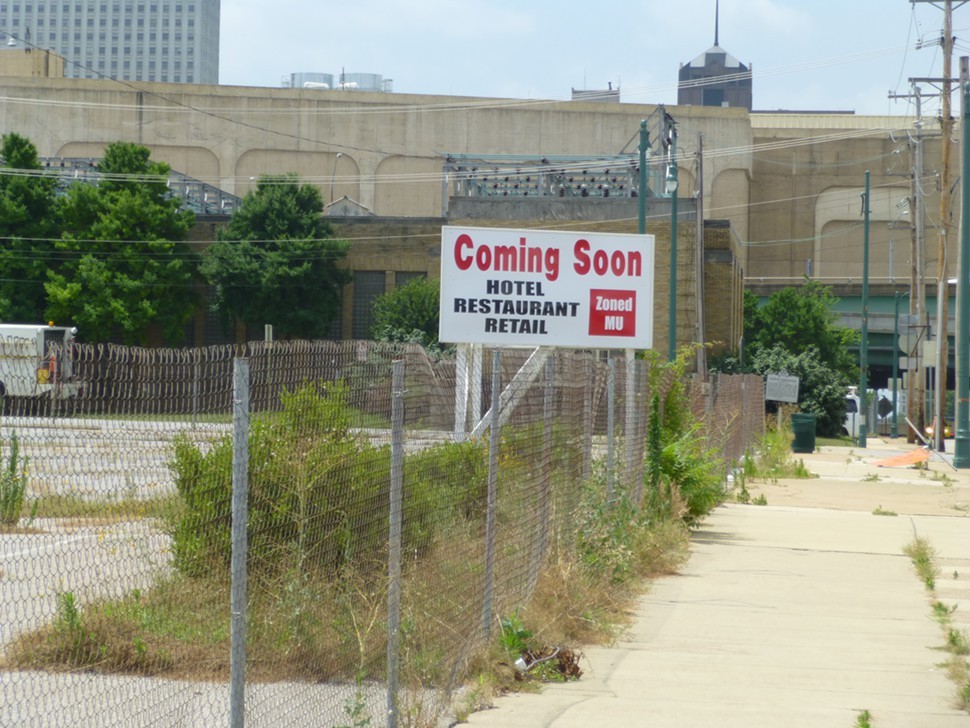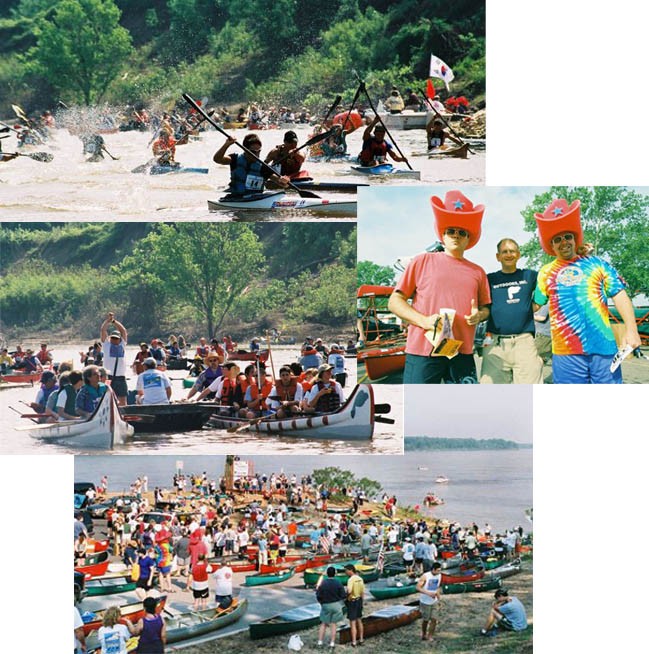My obituary was going to read something like this: “Village idiot Toby Sells died today in a totally unnecessary paddling trip down the Mississippi River. Sells was a Middle Tennessee transplant (read hillbilly outsider) and lacked the respect for the river and experience such a trip demanded. Sells’ two friends survived the journey and said he would have wanted them to drink the rest of his beer.”
The possibility of a watery death had passed through my mind a few times in the week leading up to our weekend trip. It’s the same type of fear that pulses through you right before you get on a rickety carnival ride at the county fair. You’re sure it’s going to be fine, but there’s still a chance it might not be. And an overnight trip on the big river is much more involved than a five-minute spin on the Zipper.
Memphians have a binary view of the Mississippi. They love watching the pink-and-purple sunsets over the river, but they think touching that muddy water might melt them like the Wicked Witch — or kill them instantly. For many Mid-Southerners, the river is a giant brown bogeyman whose liquid tongue slurps men into its muddy maw and tumbles them in its airless gut, never to be seen again. Whirlpools stretch in the imagination to ship-swallowing vortexes. Tree trunks launch like missiles from below to break boats and wreck lives.
Why the fear? Because people do die on the river. The fear has been needlessly exaggerated, but there are real dangers if you don’t respect the river and learn its ways.
But consider: For generations, Americans have paddled, boated, swum, and fished in the Mississippi River. It is the river of Huck Finn and Tom Sawyer, as quintessentially American as Samuel Clemens and David Crockett. Today, there are lots of people safely navigating the river in kayaks, canoes, pleasure boats, and Jet Skis. If you doubt it, visit the Mud Island Marina some weekend. You’ll be amazed at all the Memphians getting out on the water.
These comforting thoughts, and others not so comforting, surge through my mind as I watch my kayak bob in the muddy Mississippi just before we push off the boat ramp at Shelby Forest. I have kayaked the Mississippi twice before, once on the same route we were about to paddle, but there’s always a tingle of fear and anticipation. But after a long conversation with Joe Royer of Outdoors Inc., I was ready to set aside my fear for good and get on the river and enjoy it. As Royer says, we all need to learn to “be a good river person.”
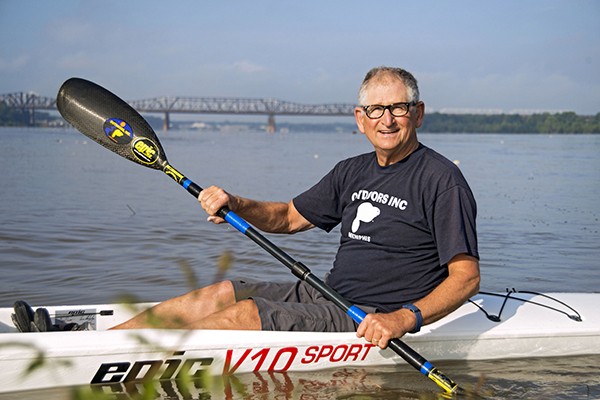
Outdoors Inc. owner Joe Royer paddles the Mississippi nearly every day
The River Man
Joe Royer knows why the Big Muddy is muddy. It’s a scientific fact that he reels off the top of his mind the way most of us cite our phone numbers.
“The soil in our area is a type of loess, which is a windblown silt of very small particles,” Royer says. “In Nashville, Chattanooga, or Little Rock, the particles of soil there are about 500 times larger.”
Water usually runs clearer in those areas, as the big, heavy soil particles settle to the bottom. But the small particles in the Wolf, Loosahatchie, and Mississippi rivers stay suspended.
“That’s why those rivers are muddy,” Royer says. “But I like to call them turbid.”
This is the long way of saying Joe Royer is familiar with the Mississippi River like few others are. He calls it, simply, “the river,” and it’s clear which one he means. He knows it intimately — how it works, how to paddle it, where to paddle, and the names of its bridges, bluffs, and islands. He’s traveled the world and always comes home to the river. He calls it our city’s biggest natural draw, our Himalayas. If the Rocky Mountains are a top-shelf margarita, he says, the river and the rolling hills of West Tennessee are a glass of fine pinot noir.
He knows many Mid-Southerners don’t feel that way. “Everybody says the river is our greatest asset. Well, I don’t think enough of us believe it,” Royer says. “It’s a pretty sunset and [people know] it’s there, but it really is undervalued.”
Royer has been getting people on the river since 1974, outfitting paddlers and campers from his business, Outdoors Inc. This weekend, he’ll oversee the 34th running of “the South’s biggest paddling event” (according to Canoe & Kayak magazine), the Outdoors Inc. Canoe & Kayak Race.
Yes, Royer has been talking up the Mississippi River for a long time — to anyone who will listen.
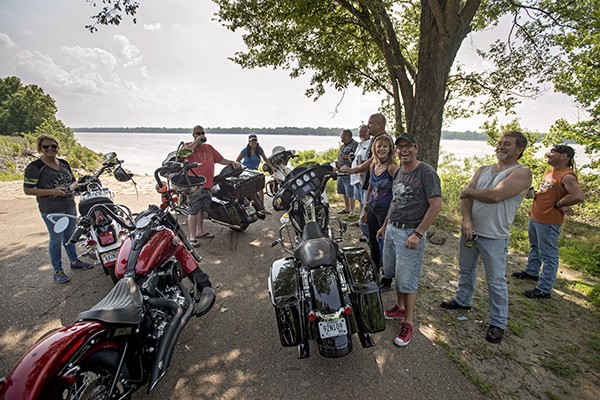
Bikers at the Shelby Forest boat ramp
The Shelby Forest boat ramp is busy on a Sunday
afternoon. A handful of bikers and their ladies drink beer in the shade at the top of the steep ramp. They watch with curiosity as my buddies, Brandon Dill and Will Freiman, and I get our boats and gear from the car.
Brandon is a photographer (for this very story). Will co-owns the Hot Mess burrito truck. Brandon talks the bikers into letting him take a photograph. They ask how far we’re going and can’t believe it when we tell them we’re paddling to Memphis, about 17 miles. They send us off with a “Well, by God, be careful out there.”
We load our gear — everything from tripods to toilet paper, bug spray to Gatorade — into our boats and head down the ramp. At the bottom, another group of bikers is talking and watching the river. They also ask how far we’re going and send us off with a “Holy shit! Y’all be careful out there.”
Now, there’s no turning back. My wife, who drove us to the ramp, has left. I zone out for a moment, watching my boat bob in the water. My life jacket’s on. My boat’s in good shape. I’m healthy and a good swimmer. My friends are true. There’s plenty of daylight left.

Toby Sells (foreground) and Will Freiman paddle the Mississippi
And I’m fine with losing this boat and everything in it.
With negative and positive thoughts at some sort of appropriate balance, I turn off my brain and paddle away from the ramp and into one of the biggest rivers in the world.
The Morning Paddler
The main motivation to do an overnight on the river for this story came from a long conversation I had with Royer back in April. He fit me in for an interview between his morning paddle and a business meeting. Some people run in the morning — or lift, or swim. The 67-year-old Royer paddles a kayak, nearly every day.
Most of the time, he points his long, pointy boat north into the Mississippi’s current from the southern tip of Mud Island and paddles to the Wolf River at the north end of Greenbelt Park. The morning I met him he’d done an out-and-back in the Wolf River Harbor, because he could do the the six-mile, slack-water paddle in about two hours.
You don’t really have to ask Royer many questions. In fact, just one will do. He’ll take it from there, talking long and passionately about the river and how he came to love it.
He grew up in Milan, Tennessee, where he learned to paddle in his father’s square stern canoe. He also began riding bicycles as a boy, another of his life-long loves. He got a master’s in engineering from the University of Memphis and interned on the river for two summers with the U.S. Army Corps of Engineers. During that time, Royer learned how the river works — about wing dikes, Bernoulli’s equation in fluid dynamics, channel flow, and more.
In those days, Royer wanted to be a kayaker for the U.S. Olympic team. He spent time on the World Cup circuit and eventually became “a good kayaker, not a great one.”
“When I retired from that World Cup circuit, I wanted to bring recreation to Memphis,” Royer says. “But, at the time, I was racing all over the U.S. and Europe. That and a dollar-and-a-half will get you a cup of coffee at Bluff City.” He’d fallen in love with the river, understood it from an engineer’s standpoint, and began using it as a training gym, the way Rocky Balboa used Philadelphia. Since then, he says his mission has been to call attention to the river, which is why he started the canoe and kayak race.
“The reason I’m passionate about the river is because that’s what we’ve got,” Royer says. “I don’t have the Rockies or the Smokies. I don’t have the Ozarks. I love all those, but this is what I’ve got.”
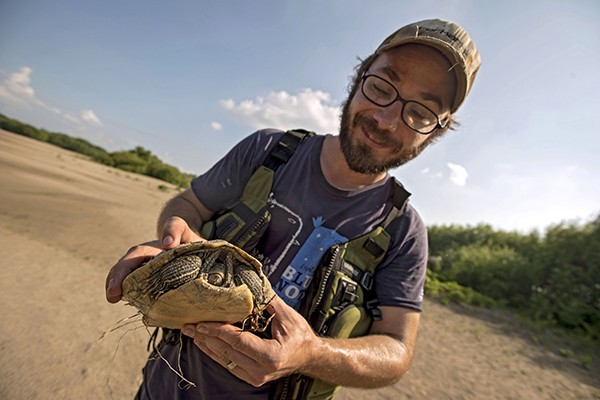
Freiman finds a turtle on a sandbar
We’ve paddled about an hour from the ramp when Brandon scouts a nice-looking sandbar ahead. We pull out of the main river channel and into a shallow pass to the eastern side of the bar. My boat slides to a stop on the muddy bank, and I look up in time to see a small coyote chasing four white birds. The coyote brakes hard at the sight of us and scrabbles for a patch of scrub on top of the hill. Will finds a turtle.
Gentle waves lap the western side of the bar, and the silky sand feels smoother than anything on the Gulf Coast. I stop, close my eyes, and indeed feel like I am on a beach. Serenity flows over me as the breeze caresses my face and …DING! Text message. It’s the boss.
Flyer editor Bruce VanWyngarden had told us he might meet us on the river, zipping up in his small boat that he keeps docked at Mud Island Marina. His text said he was on the way to our agreed-upon rendezvous at Hickman Bar, where we’d likely camp that night. We start paddling for the bar (not knowing exactly how long it would take us to get there). Apparently, it’s going to take a lot longer than we thought.
Bruce eventually finds us on the river and says we have about another 45 minutes of paddling to the sandbar. Well, that won’t do. There was beer to drink. So, we, er, I hatched a plan. He’d tow me. (I’m not saying it was a good plan.)
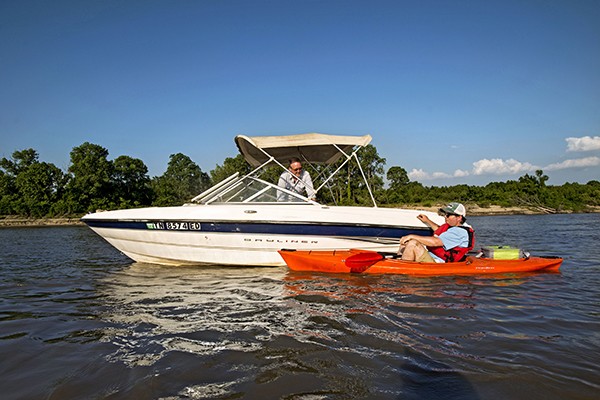
Flyer editor Bruce VanWyngarden attempts to give Sells a tow.
At first, I try to hold onto a deck cleat on the side of his boat and ride down the river Marty McFly style. I nearly tump immediately. Then, I decide to try to “ski” behind him (very slowly) holding the boat’s anchor rope. Again, I nearly tump.
“I’m just going to paddle down, man,” I say. “Otherwise, we’re going to end up on one of those ‘watch-this-dumb-redneck’ videos on YouTube.”
There’s a majesty in sitting in a kayak on the Mississippi River. It swallows you up — a mile wide in parts — but it’s mostly gentle, quiet. The landscape slides easily by. Look closely and you can spot a bald eagle or an osprey. The current sometimes rocks you as you pass over a dike, coasting along at three to five miles per hour. But that speed brings a reality to the majesty: You have to actually paddle if you want to get anywhere.
Your torso is like a bike’s chainwheel. Your arms are the cranks. The paddle blades are the pedals. Your shoulders, hands — and butt — can get sore. But when I finally see the place where Bruce is idling his boat, the paddle seems worth the effort.
The Race Director
In April, when I first spoke to Royer in his South Bluffs home, his mind was already on the third weekend in June. He plunked down a huge file folder, shaggy with sheets of paper, tabs, and Post-it Notes. At five inches thick, it landed with a thud on his kitchen counter. “This is the permit process for doing this event,” he says, leafing through the stack of staging plans, emergency plans, permits (from the Tennessee Wildlife Resources Agency, the Memphis Police Department’s Harbor Patrol, the U.S. Coast Guard), training guides for safety boat operators, and more.
The key to a successful event, he says, is a focus on the basics. Follow the rules. Bring in independent race officials. Start on time. Get the results right. Take your stuff down. Leave the landscape and river cleaner than you found it.
By the time the starting pistol fires on the race this Saturday, Royer and a staff of his employees and volunteers will have been at work for hours, the river will be closed to barge traffic, and 10 safety boats and the Coast Guard will be in place.
Royer’s race helped land Memphis on Canoe & Kayak magazine’s 2015 list of North America’s Best Paddling Towns.
Here’s what the magazine had to say: “The Big Muddy, with its intimate back channels and quiet tributaries like the Wolf River, also makes Memphis a first-rate paddling town. … In the (Outdoors Inc. Canoe and Kayak Race’s) trademark mass start, Olympic gold medalists rub gunwales with first-time paddlers, and everybody has a good time.”
Paddling on the Mississippi is an established part of Memphis kayak and canoe culture now, but that wasn’t always so.
“Locally, it was kind of rejected by the paddling community, at first,” Royer says. “They said Memphis sucks. We have to go to Arkansas. We have to go to Destin. We have to go to East Tennessee.”

We crack beers and begin to scout the island we’ll call home for a night. The main river channel on the western side and a back channel on the eastern side are connected by a shallow stream running between them. Above the stream, a flat, sandy landing will be our tent city. We’ll build a fire pit into a nearby shelf of earth and sand. Bruce says the spot is one of his favorites, and footprints tell us someone has been here recently. Call it a river hot spot, the Huck Finn Inn.

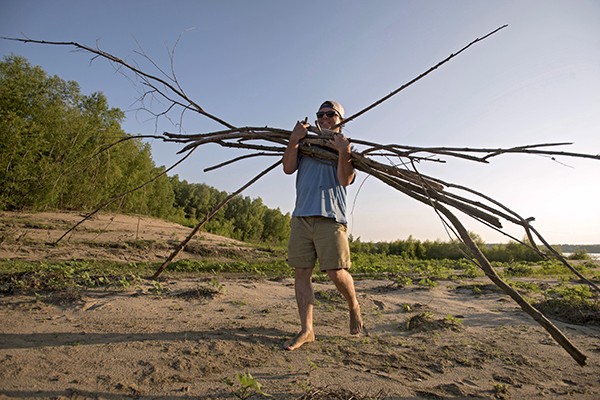
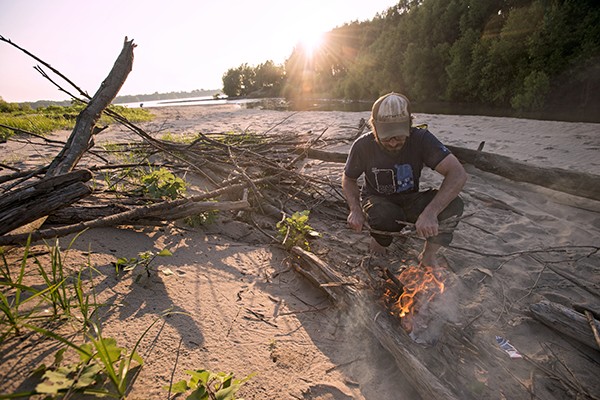
Soon, Bruce heads back to Memphis, and the real camping begins. Firewood is scavenged from the woods. Kayaks are secured and unloaded. Tents are poled and staked. Brandon and Will commence to making a fire with a verve that seems to be tapped from their inner 10-year-old.

We walk to the wing dike and watch a pink-and-purple sunset. Will waves to a passing barge that gives him a long, loud toot. Brandon produces a cast-iron skillet, brats, beans, and two bags of Zapp’s chips. I produce a bag of boneless chicken wings from the Kroger deli and a tube of Pringles (salt and vinegar).

Tired and full, we settle in under the darkening sky with campfire conversations, fueled by beer and bourbon. Frogs — hundreds of them — converse all around us with a single word repeated louder and louder. REE-Yote. REE-Yote. REE-Yote. A cloud of lightning bugs illuminates the dark woods behind us like a shimmering lace pillowcase. Jupiter shines overhead.
Then Will hears something, a scurrying sound. Brandon hears it, too. I’m still laughing about something when I see my companions stand — on high alert.
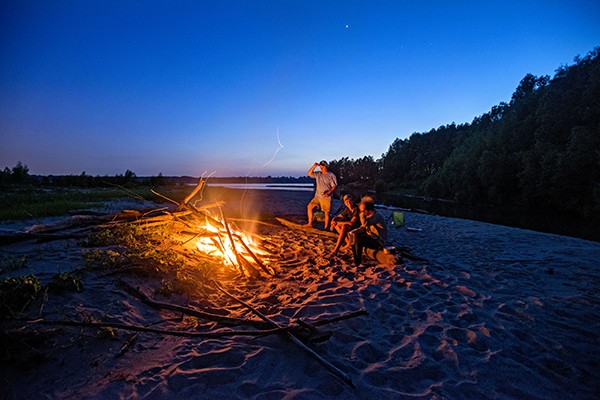
Will flicks on his flashlight, and I spot something small, but not small enough for me to want to stay seated. Will follows it into the brush and finds … a glistening, wet armadillo. We shoo the little devil until he high-tails it into woodsy terrain too technical for unsupervised drinking men.
Joe Royer started Outdoors Inc. in a one-bedroom apartment in Memphis. It was originally called West Tennessee Whitewater Supply. A friend, Lawrence Migliara, had something similar going in his living room, so they threw in together and opened the Great Outdoors. The rent was $60 per month for a place on Cleveland. It was open Tuesday and Thursday nights for two hours. “People would leave notes on our door, asking, ‘Are you guys ever open?'” Royer says.
They eventually opened locations in East Memphis, in Midtown, and on Germantown Parkway and shortened the name to Outdoors Inc.
Royer stays happy in the outdoors business, he says, because he still rides a bike and paddles a kayak. “For outdoor businessmen who just look at sales numbers, it’s never enough,” Royer says.
“My best trait as a business person is to not underestimate Memphians. Memphians have been climbing mountains and paddling kayaks and running marathons — and they’re very skilled and very professional — for a long time. I didn’t bring that to Memphis. That was here.”
Paddling the Mississippi is about the most Memphis thing you can possibly do.
That’s what I’m thinking during our morning float, as we get closer to the city skyline and the M Bridge.
Barges pass. Cars slide noiselessly across the bridge overhead. Though I can’t see them, I’m sure suited professionals are already hard at work in the Raymond James Tower building and tourists are eating fudge at the Bass Pro Shops at the Pyramid.
And here we are, unwashed, hungover, a little wet and sun-sapped. But the morning is bright and clear, the city and the river are alive. I feel like I’m part of it in a brand-new way.
We pull our boats out at Wolf River Harbor and take stock. We are unharmed, haven’t lost anything, and don’t even have sunburns or mosquito bites. We’d mixed caution and adventure and had a great outing. That’s what you want from the river.
And it made me think of something Royer told me back in April. “The fact that the river is so big and so powerful …,” he said. “We have to embrace that.”
Indeed, we do.
